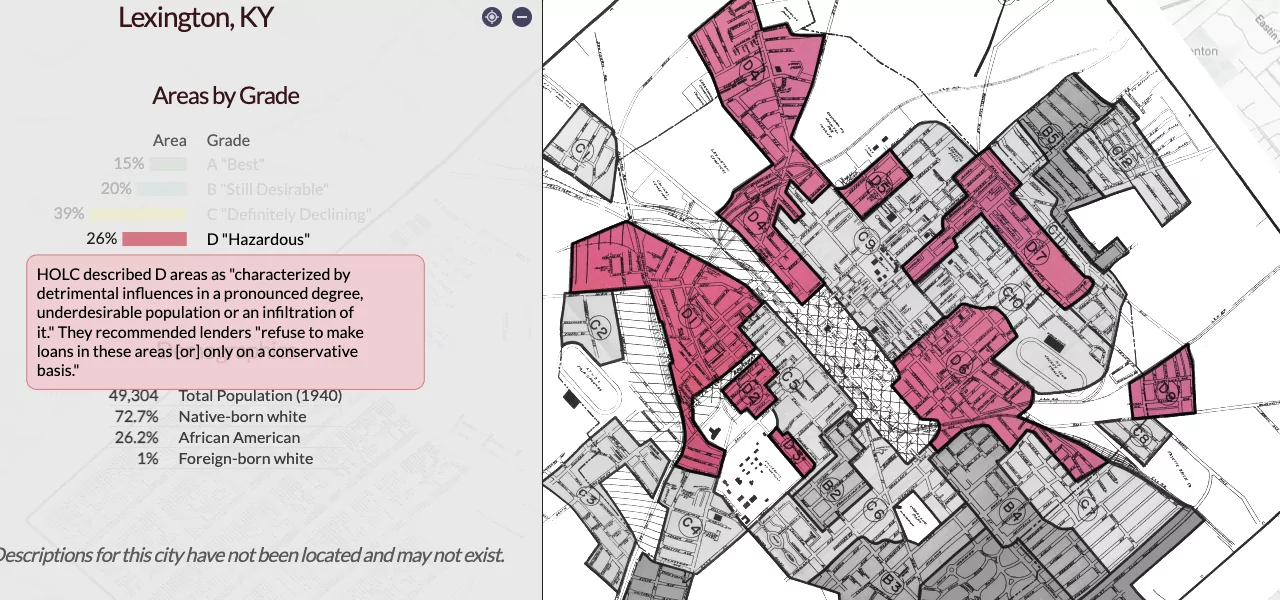Redlining, history, and the anatomy of inequality in Lexington, Ky

We recently created an interactive map of Lexington’s redlined neighborhoods. The map was based on a 1940 map used by bankers to determine what areas they would issue home loans in. The mere presence of a black resident was enough to get the area redlined back then.
These lines on a map carved out what became Lexington’s historically black neighborhoods–the same neighborhoods that have been hit the hardest by gentrification. Today we will take a deeper look at one area of town that was redlined and how it is doing today, compared with the rest of Fayette County. Expect additional pieces of content like this in the coming weeks, as well.
Lexington Manor; Fayette Census Tract 4
The first redlined neighborhood we will highlight is Lexington Manor, bordered by modern day Winchester Road (known as Winchester Pike in 1940) on the south, East Loudon Avenue to the east, railroad tracks to the north, and the site of the historic KY Jockey Club racetrack to the west. The racetrack, Keeneland’s predecessor, closed in 1933 and was demolished in 1935. Lexington Manor is one of two redlined neighborhoods near the track where its black workers lived.
The racetrack later became the Bluegrass-Aspendale housing project. The development was built in stages between 1936 and 1951 and was Lexington’s first venture into public housing. It was segregated initially and wasn’t until 1974 that a 300 yard fence was torn down. The complex had 963 units at it’s peak and around 1990 the Lexington Housing Authority began to thin out the neighborhood by demolishing 295 units. In October 2005 they received a federal grant to demolish the remainder of the structures, which can be seen in this photograph. The site was then redeveloped with single family homes and apartments and the addition of William Wells Brown elementary school.

Demographics
The modern day population of Census Tract 4, which encompasses Lexington Manor, is 32% White, 40% Black, and 20% Hispanic, according to US Census Bureau estimates. The per capita income of the census tract is $12,692, about one-third the per capita income of Fayette County as a whole. The median household income of the census tract is $28,084, about half the median household income of Fayette County as a whole.
Child poverty rate over double Fayette County as a whole
38.9% of Fayette Census Tract 4 residents live below the poverty line, which is more than double the 15.8% poverty rate for Fayette County as a whole. 64% of children live in poverty, compared to 19% of children in Fayette County as a whole.

Declining owner occupancy of housing units
The area is also very renter-heavy. Currently, only 30% of occupied housing units are owner-occupied, compared to a 55% owner-occupancy rate in Fayette County as a whole. The average value of an owner-occupied housing unit is $135,900, compared to $200,900 for Fayette County as a whole. Additionally, the percentage of long-term residents is fewer than other areas of Fayette County, with 80% of the area’s residents moving there since 2010.
Few long term residents is a key sign of gentrification at work. Because bankers would not give loans for homes in these areas, property values in the area were depressed during the Jim Crow era and the years that followed. However, the depressed values represented an opportunity for someone who wished to buy a home for cheap. Many black homeowners purchased affordable homes in redlined neighborhoods during Jim Crow and the years that followed. These areas became Lexington’s historic “black neighborhoods” that we think of today. However, as property values began to rise and “urban renewal” reared its head, older residents, many on a fixed income, could not afford the property taxes and/or upkeep on their homes.
One notorious Lexington gentrifier was known to patrol disadvantaged neighborhoods for code enforcement violations. When he found one, he would report it to the city, wait a few days, and then make an offer to buy the property if the owner could not afford to conduct the repairs themselves. Many long-term residents have been forced out of their homes due to these and other efforts by gentrifiers. The new owners of these homes will typically do some superficial repairs, set the rent at a seemingly exorbitant “market rate,” and advertise the home as being in a “trendy, up and coming” area.
Poor schools and lagging educational attainment
Educational attainment in disadvantaged areas generally lags behind in the United States. It should be no surprise that Census Tract 4 is no exception. The nearest elementary school, William Wells Brown Elementary, received a “red” overall performance rating on the Federal Classification scale.

Conclusion
There’s a lot to unpack here, but one thing is clear, the residents of this area have been at a structural disadvantage for a long time. Those who managed to buy homes in the area when it was affordable are now having those homes systematically and sometimes violently taken from them by gentrifiers who want to use them as “investments” for their own personal gain.
Sources
- U.S. Census Bureau (2020). American Community Survey 5-year estimates. Retrieved from Census Reporter Profile page for Census Tract 4, Fayette, KY <http://censusreporter.org/profiles/14000US21067000400-census-tract-4-fayette-ky/>
- Mapping Inequality – Redlining in New Deal America
- US Census Quick Facts – Lexington-Fayette
- Dispelling the Myths of Lexington’s Gentrification Apologists


Recommended Posts

Environmental Service’s community outreach update
Mon, October 21, 2024

Changes come to Lexington snow plow routes
Mon, October 21, 2024
KY Secretary of State Adams discusses voter roll ‘clean-up,’ praises election volunteers
Mon, October 21, 2024






